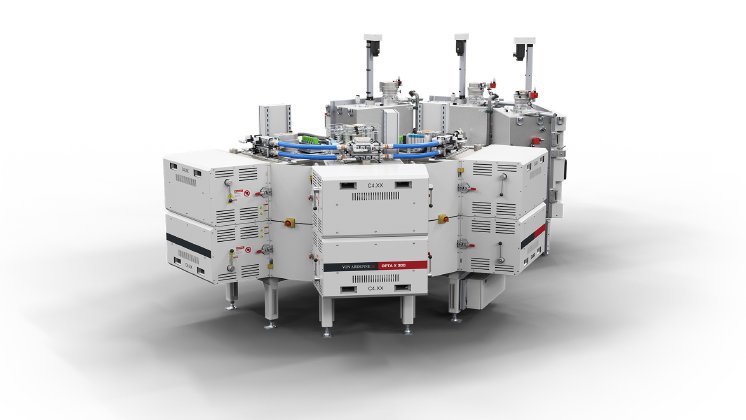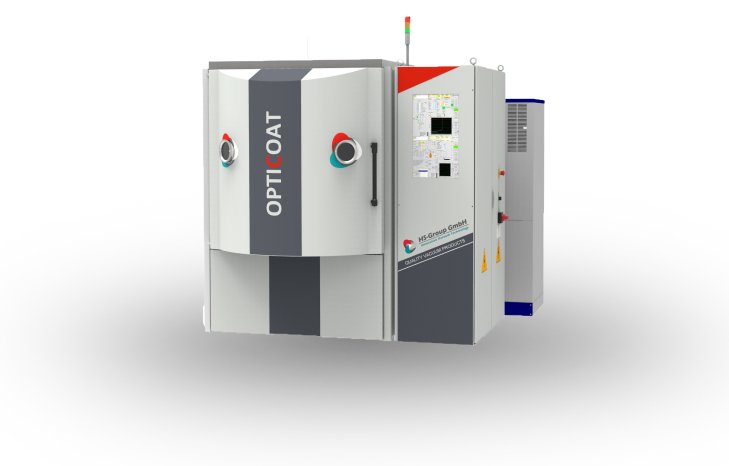Together they master the important key technologies and processes: Ion beam etching, electron beam evaporation and magnetron sputtering. This enables the group to offer coating solutions for applications ranging from simple optical requirements to high-precision optics, from micro to macro optics.
The three companies of the VON ARDENNE Group, VON ARDENNE GmbH, scia Systems GmbH and HS-Group GmbH, will be exhibiting at Optatec 2024 in Frankfurt from May 14 to 16. They will present a broad portfolio with the latest process solutions and systems for coating and structuring, based on advanced ion beam and plasma technologies.
The applications for these technologies are diverse: highly reflective and anti-reflective coatings, shape error correction for X-ray and telescope mirrors, structuring of optical gratings for augmented reality (AR) glasses, interference layers for AR/VR/XR components, layers for head-up displays or filter layers for semiconductor electronics.
VON ARDENNE presents high-precision coating systems for optical applications on substrates up to 300 millimeters wide
With the OPTA X platform, VON ARDENNE offers an industrial coating solution for sophisticated optical filters, dielectric mirrors, and metallic alternating layer systems of the highest precision on substrates of various sizes and geometries. The initial focus was on optical components with a diameter of up to 200 millimetres.
In order to meet the demand for precision optical coatings for larger components, such as those required in the areas of consumer electronics (AR/VR/XR), automotive (HUD, interior/display glass) or semiconductors (wafer level optics), VON ARDENNE now also offers the OPTA X for 300 mm coating widths - as the OPTA X 300.
Thanks to the advanced process technology of the OPTA X, extremely precise coating thicknesses can be achieved, typically with a deviation of less than ±0.25 %. Another special feature is that interference optical coatings deposited with this accuracy can be applied simultaneously to the front and back of the optical component. This significantly shortens the production time.
The OPTA X can be optimally integrated into industrial production processes. This is also due to the fact that it is equipped with an optical monitoring system for in-situ process monitoring and quality control as well as comprehensive software control and automation for continuous component placement.
At Optatec, the company will also be providing comprehensive information on other vacuum coating solutions for applications ranging from micro-optics to large telescopes.
scia Systems presents ion beam and plasma technologies for the precise processing of high-tech optics
scia Systems GmbH, the technology leader for high-precision, complex ion beam and plasma processing equipment in the microelectronics, MEMS and precision optics industries, will be presenting the latest process solutions for coating and structuring at Optatec. These are based on advanced ion beam and plasma technologies.
One of the biggest technological challenges associated with augmented reality (AR) and mixed reality (MR) glasses is the production of optical waveguides. Both technologies use diffraction gratings, known as surface relief gratings (SRGs), to couple the light in and out between the display and the eye. For an optimum coupling effect and therefore high brightness, the SRG must be aligned at an angle to create a so-called "slanted grating". Sophisticated grating designs often require different tilt angles and etching depths. The slanted gratings can either be etched directly into the waveguide or into a master stamp, which is used to manufacture the AR/MR display using nanoimprint lithography (NIL).
Reactive ion beam etching (RIBE) is ideal for producing grating structures with constant tilt angles. The use of reactive gases in the etching process makes it possible to adjust the selectivity of different surface materials or to increase the etching rate. The substrate can be tilted so that it can be etched at an angle of up to 60 degrees. A chrome mask is often applied to the substrate material to define the lattice structures.
Reactive ion beam trimming (RIBT) is used to vary the tilt angle and etch depth on the substrate. With RIBT technology, a focused wide ion beam scans over the surface, whereby the angle of incidence and the dwell time on the substrate can be varied during the etching process. This allows the angle of inclination of the individual trenches and the etching depth to be precisely controlled. This in turn enables uniform image illumination for the wearer of the glasses.
scia Systems offers solutions for structuring waveguides and NIL master stamps for both the RIBE and RIBT processes, both for industrial volume production and for research and development.
The systems are used for coating, etching and cleaning processes with nanometer precision and have proven themselves in various high-tech industries worldwide, including the microelectronics, MEMS and precision optics industries.
The HS-Group presents the advantages of retrofits and OPTICOAT coating systems
The HS-Group has been an expert in manufacturer-independent modernization (retrofits) of vacuum systems and the development of proven vapor deposition solutions for 30 years.
In the rapidly developing optical industry, neglected and outdated vacuum systems can have serious consequences. This is where retrofits come into play. It's not just about upgrades. Rather, it's about strategically investing in the longevity and performance of older vacuum machines. The failure of obsolete components can cause considerable costs and disruptions, especially in vacuum coating, which can far exceed the costs of a well-planned system modernization.
With many years of experience in the retrofit business, we have encountered numerous challenges due to delayed retrofit considerations. This is exactly where the HS-Group offers comprehensive solutions for the modernization of your optical coating system. Let us advise you on what modernization is possible for your older existing systems.
In addition, the company's OPTICOAT series offers a tried-and-tested solution for a wide range of optical coatings. This state-of-the-art technology enables the precise application of high-quality thin films to optical components. With outstanding product quality, easy handling and reliable performance in daily use, our coating systems are the optimal choice for customers' requirements.
At the trade fair, visitors will be able to find out more about the diverse applications of the OPTICOAT series, including anti-reflective coatings, edge filters, bandpass filters, beam splitters and highly reflective mirrors. And they can get advice on how to increase the performance of their optical products.
With chamber sizes from 700 mm to 1500 mm and a wide range of technologies, such as electron beam evaporation, ion beam assisted coatings or optical monitoring, the OPTICOAT series is perfectly suited for research, development and mass production.
At Optatec, visitors can find out how they can optimize their optical coating processes with the HS Group's innovative solutions.
The VON ARDENNE Group at Optatec 2024
Time: 14 – 16 May 2024
9 a.m. - 5 p.m.
Location:
VON ARDENNE & HS-Group: Booth 318 in Hall 3.1
scia Systems: Booth 715 in hall 3.1



